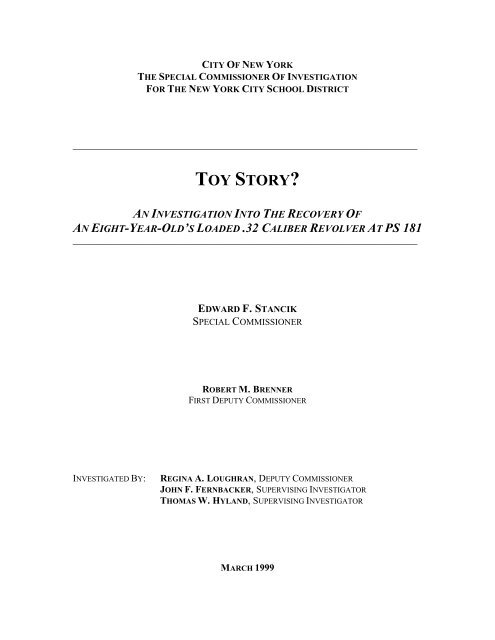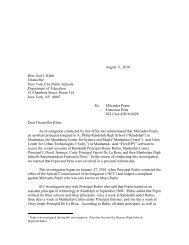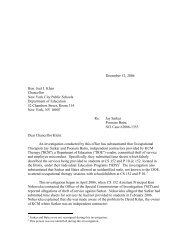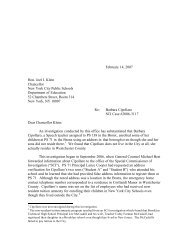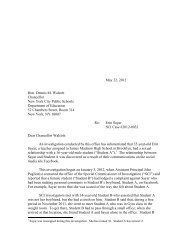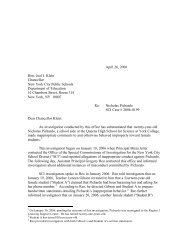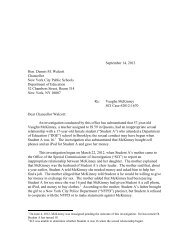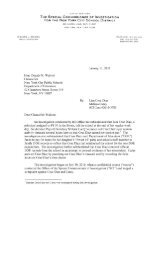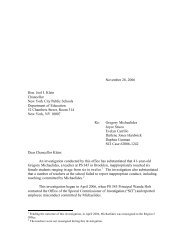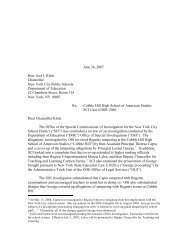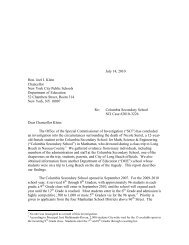You also want an ePaper? Increase the reach of your titles
YUMPU automatically turns print PDFs into web optimized ePapers that Google loves.
CITY OF NEW YORK<br />
THE SPECIAL COMMISSIONER OF INVESTIGATION<br />
FOR THE NEW YORK CITY SCHOOL DISTRICT<br />
_______________________________________________________________________<br />
TOY STORY?<br />
AN INVESTIGATION INTO THE RECOVERY OF<br />
AN EIGHT-YEAR-OLD’S LOADED .32 CALIBER REVOLVER AT PS 181<br />
_______________________________________________________________________<br />
EDWARD F. STANCIK<br />
SPECIAL COMMISSIONER<br />
ROBERT M. BRENNER<br />
FIRST DEPUTY COMMISSIONER<br />
INVESTIGATED BY: REGINA A. LOUGHRAN, DEPUTY COMMISSIONER<br />
JOHN F. FERNBACKER, SUPERVISING INVESTIGATOR<br />
THOMAS W. HYLAND, SUPERVISING INVESTIGATOR<br />
MARCH 1999
TOY STORY?<br />
AN INVESTIGATION INTO THE RECOVERY OF<br />
AN EIGHT-YEAR-OLD’S LOADED .32 CALIBER REVOLVER AT PS 181<br />
ACKNOWLEDGEMENTS<br />
This case was investigated under the supervision of Chief Investigator Thomas<br />
Fennell and Deputy Chief Investigators Thomas Comiskey and Maureen Spencer. Joseph<br />
Lamendola and George Johansen, both senior investigators formerly with this office,<br />
assisted in gathering evidence about the gun.<br />
We gratefully acknowledge the assistance of the New York City Police<br />
Department; in particular, members of the 105 th Precinct, Officer Kim Andrews, and<br />
Detective John O’Malley.
TOY STORY?<br />
AN INVESTIGATION INTO THE RECOVERY OF<br />
AN EIGHT-YEAR-OLD’S LOADED .32 CALIBER REVOLVER AT PS 181<br />
BACKGROUND<br />
On the afternoon of April 3, 1998, a paraprofessional at PS 181, located within<br />
District 29 in Queens, learned from an eight-year-old third grader (“Student A”) that his<br />
classmate (“Student B”) had a gun in his backpack. Moreover, Student A was scared<br />
because Student B had threatened to shoot him if he told anyone. Along with a custodial<br />
worker and Student A, the paraprofessional entered the boy’s classroom, found Student<br />
B’s backpack, and verified that there was a gun inside.<br />
While the foregoing fact pattern would be alarming under any circumstances, the<br />
paraprofessional’s discovery was all the more frightening given that—just two weeks<br />
earlier—two students in Jonesboro, Arkansas, brought weapons to school and used them<br />
to kill and wound classmates and teachers. The Jonesboro massacre—the worst case<br />
scenario for the combination of children and guns—made the response by the school<br />
principal and the district superintendent to the weapon in Student B’s backpack, even<br />
more disturbing.<br />
The paraprofessional, Andrea Clarke-White, immediately took the pack—weapon<br />
included—to the principal, Ronald Zimmerman. Zimmerman slipped the gun in his<br />
pocket and took it to the District 29 Superintendent Celestine Miller. There, her assistant<br />
placed it in a cabinet for the weekend. Despite the fact that the gun recovered on Friday<br />
afternoon was a loaded firearm—unlicensed possession of which is a felony in New York
State—it was not turned over to the police until Monday morning. When Miller<br />
defended this action, claiming that the weapon was thought to be a “toy,” we began our<br />
investigation to determine the likelihood of that explanation.<br />
We examined the gun—a .32 caliber silver revolver with a black handle—and, in<br />
our view, no reasonable individual could conclude it was a toy. The weight alone is<br />
inconsistent with fake weapons, including pre-plastic toys. Moreover, the cylinder which<br />
houses the ammunition is partially exposed, so that when loaded—as it was on April<br />
3 rd —the bullets are visible. Thus, we concluded that the gun was obviously “real,” and<br />
that both the principal and the superintendent knew or should have known that fact.<br />
Indeed, by all accounts, the actions of those involved with the weapon are inconsistent<br />
with how one would act if the handgun were a toy. Consequently, we found that the toy<br />
story was an excuse manufactured by the superintendent to deflect criticism.<br />
This report describes the incident at PS 181 and the fallout it created. Although<br />
Zimmerman and Miller gave drastically different versions of the facts, the issue remained<br />
constant: once the gun came to their attention, it was incumbent upon them to determine<br />
if it was genuine and, upon any doubt, to contact law enforcement for assistance.<br />
Ultimately, we found that both those administrators—to varying degrees—mishandled<br />
the situation. Finally, we recommend that disciplinary action be taken against the<br />
principal and that the superintendent be terminated from her position.
“I LOOKED IN THE BOOK BAG, I SAW A BLACK HANDLE, I TOOK THE GUN OUT AND<br />
LOOKED AT IT QUICKLY, AND THEN I PUT IT INTO MY POCKET”<br />
—TESTIMONY OF PRINCIPAL RONALD ZIMMERMAN<br />
On their way to school in the Springfield Gardens section of Queens on the<br />
morning of April 3, 1998, Student A and his sister met Student B who pulled a gun from<br />
his backpack and pointed it at them. Then, he threatened to shoot Student A if he told<br />
anyone about the gun. Any doubts about the authenticity of the item vanished when the<br />
gun opened and a bullet dropped out. Student A and his sister hurried away while<br />
Student B reloaded the firearm.<br />
At school, Student A remained fearful of Student B. Finally, at lunchtime, he told<br />
Andrea Clarke-White, a paraprofessional, who had noticed that the boy was acting<br />
strangely, about Student B threatening him with a gun. In fact, Student A took Clarke-<br />
White, along with a custodial cleaner who had the key to the classroom, to the weapon<br />
which was still in Student B’s backpack.<br />
Recognizing the significance of her discovery, Clarke-White immediately took<br />
the backpack and its contents to PS 181 Principal Ronald Zimmerman. 1 According to<br />
Clarke-White, the principal removed the gun and examined it; he then told her to return<br />
to class and he would handle the situation. 2 Zimmerman slipped the gun into his pocket<br />
and went in search of Student B. 3 Upon locating the boy, Zimmerman drove him home.<br />
1 Effective May 11, 1998, Zimmerman was assigned to administrative duty by Community School District<br />
29 Superintendent Celestine Miller. In February 1999, he was successful in overturning her decision when<br />
Miller agreed to settle the matter and return him to his duties as principal at PS 181.<br />
2 The principal did not learn about the threat at that time.<br />
3 According to Zimmerman, he called the district office to report the recovery of the weapon, but was not<br />
able to speak with anyone of authority. When we attempted to review telephone logs, the district was not<br />
able to produce all messages taken that day.
During the ride, Student B claimed that he “found the weapon on the street.”<br />
“I HAD THE GUN, IT WAS IN MY POSSESSION, THEREFORE IT WAS SAFE”<br />
—TESTIMONY OF PRINCIPAL RONALD ZIMMERMAN<br />
With Student A back in class, Student B at home, and the gun “safeguarded” in<br />
his pocket, Zimmerman headed to the Community School District 29 Office. 4 According<br />
to him, once there, he entered the office of the superintendent, Celestine Miller, told her a<br />
child brought a gun to school, and placed the weapon on her desk where it was clearly<br />
visible. To the contrary, Miller asserts that Zimmerman placed a bag on her desk and<br />
said it contained a “toy” gun he confiscated from a student. The superintendent claims<br />
she did not look in the bag. 5 We do not find Miller’s testimony on this point to be<br />
credible. Since the gun is so clearly authentic, it is illogical that Zimmerman would call<br />
it a toy. Nor does it make any sense that he would travel to Miller’s office on a Friday<br />
afternoon to turn in a harmless plaything. In any event, Miller had an obligation to<br />
determine whether the item was real or not, and to have the police examine the weapon<br />
and take it into custody, if there was even the slightest chance that the gun was an<br />
operable firearm.<br />
Instead, Miller simply called in her special assistant, Michael Blum, and ordered<br />
him to take control of the “toy gun” and to schedule a meeting with Student B’s parents<br />
4 Although this incident occurred prior to the takeover of the Board’s Division of School Safety by the New<br />
York City Police Department, Zimmerman could have taken the weapon to the School Safety Officer<br />
assigned to his school. Certainly with the police department’s current involvement with security in the<br />
schools, this situation should never be repeated.<br />
5 Miller testified: “I didn’t really have a reason to look in the paper bag. I did not want—I don’t get<br />
involved in the handling of incidents or situations. That’s the responsibility of the director of pupil<br />
personnel support services, and I just would not normally get involved in that and so I didn’t.”
for Monday morning. 6 Blum placed the weapon in a cabinet in his unlocked office for<br />
the weekend. Thus, a loaded .32 caliber revolver spent the weekend in a school district<br />
file drawer instead of the police evidence locker.<br />
“I DIDN’T EXAMINE IT CLOSELY, BUT I HAD A FEELING THAT IT WAS REAL”<br />
—TESTIMONY OF PRINCIPAL RONALD ZIMMERMAN<br />
Despite Miller’s categorization of the gun as a toy, Zimmerman thought it might<br />
be real and therefore continued to be concerned about both Student A and Student B. 7<br />
Consequently, he visited both children and their families at home. Arriving at Student<br />
B’s residence at about 8:30 p.m. Friday, he learned that the boy and his parents had been<br />
notified to appear at the district office on Monday morning.<br />
At Student A’s home, Zimmerman questioned the boy in front of his mother. 8<br />
According to the principal, for the first time, he learned that Student B threatened Student<br />
A with the gun. Over the weekend, Zimmerman continued to be concerned about the two<br />
6 Blum also testified that the item he removed from Miller’s office was in a bag. He claimed he did not<br />
look in the bag because as the hearing officer for student suspensions he did not want to be prejudiced.<br />
7 While it is possible that Zimmerman was concerned about Student A because he knew of the threat, he<br />
claims otherwise. According to him, Student B’s first explanation for possessing the gun was that he was<br />
holding it for Student A whose father was the owner of the weapon. In fact, when Zimmerman questioned<br />
Student A and his mother, much of his initial inquiry focused on the boy’s father and gun ownership.<br />
According to Zimmerman, during this conversation, for the first time, he learned about the threat.<br />
8 According to Student A and his mother, Zimmerman’s visit occurred at approximately 11:00 p.m. on<br />
Saturday night. The principal, however, insists he went there at on Friday shortly after his stop at Student<br />
B’s residence.
oys and kept in touch with the families. 9 However, he did not notify the police or<br />
anyone else about Student B’s menacing conduct.<br />
That same weekend, Michael Blum began to have his own misgivings about the<br />
events in Miller’s office on Friday afternoon. As it turned out, his worries were not<br />
misplaced. As he met with Student B’s parents on Monday morning, he realized he was<br />
not holding a toy.<br />
“I WOULDN’T GIVE THAT TO MY CHILD AS A TOY. AND IF A POLICE OFFICER<br />
SAW SOMEBODY WITH THAT IN THEIR HANDS, THEY MAY SHOOT THEM”<br />
—TESTIMONY OF SPECIAL ASSISTANT MICHAEL BLUM<br />
On Monday morning, Blum retrieved the gun to show it to Student B’s parents.<br />
Inspecting it closely for the first time, Blum realized it was very likely that the weapon<br />
was not a toy. He immediately contacted Miller who called in the district security<br />
director, Robert Hussey, a retired New York City Police detective. 10 In the presence of<br />
Miller and Blum, Hussey examined the weapon and immediately identified it as a<br />
9 Again, Zimmerman’s time frame differs from that of Student A’s family. According to them, the<br />
principal came over Sunday morning to see the boy’s father. According to Zimmerman, he visited Student<br />
A’s father on Saturday morning. However, both parties agree that Zimmerman came to see the father again<br />
on Monday morning. He also telephoned Student B’s parents to remind them about the meeting on<br />
Monday.<br />
10 Hussey holds a teacher’s license. Although he functions as Miller’s security director, at the time of his<br />
testimony in June 1998, he said he was also Interim Acting Assistant Principal at PS 109. Nevertheless,<br />
then and now, for payroll purposes, he appears as assigned to IS 159 in the position of special education<br />
teacher.
firearm. 11 Moreover, the gun was fully loaded and operable. 12 Hussey called the 105 th<br />
police precinct.<br />
While waiting for officers to arrive, Blum conducted what the Board describes as<br />
a category one—possession of a firearm in school—suspension hearing. 13 Student B’s<br />
mother pleaded “no contest” on behalf of the boy, meaning that she and her son agreed to<br />
a suspension and transfer to another school. 14 The police arrived, took possession of the<br />
gun and bullets, and placed Student B under arrest for Criminal Possession of a<br />
Weapon. 15<br />
“NONE OF US IS A GUNSMITH”<br />
—SUPERINTENDENT CELESTINE MILLER’S STATEMENT TO THE MEDIA, APRIL 7, 1998<br />
The suspension and arrest of Student B did not end the gun episode for District<br />
29. By Tuesday, April 7, 1998, the news that an eight-year-old had pointed a loaded gun<br />
at a fellow third grader and later took the weapon to school became public and a media<br />
frenzy ensued.<br />
11<br />
Although Miller denied being present while Hussey examined the gun, both he and Blum place her there.<br />
12<br />
A subsequent ballistics test performed by the New York City Police Department found the gun and the<br />
ammunition were operable.<br />
13<br />
See Regulation of the Chancellor A-440.<br />
14<br />
Later, after consultation with the Board’s law office, Blum realized that he had not given the required<br />
notice to conduct a category one hearing. The hearing was conducted again on April 20, 1998, with the<br />
same outcome.<br />
15<br />
Because of his age, Student B was charged in Family Court. Consequently, records regarding his arrest<br />
are confidential. According to the arresting officer, upon arriving at the district office she took control of<br />
the gun. Although she recalled seeing a bag in the office, as she received no information indicating that it<br />
was evidence, she did not voucher it. The officer did not know at what point, or by whom, the weapon may<br />
have been placed in the bag.
That morning, at PS 181, Miller met with parent and teachers’ union<br />
representatives to ensure them that the school was safe and secure. According to several<br />
parents who were present with the superintendent on April 7 th before she faced the media,<br />
Miller said that Zimmerman brought the gun to her on Friday afternoon and “we<br />
examined it and felt it was a toy.” 16 Miller, Hussey, and Deputy Superintendent Michael<br />
Cinquemani also met with Zimmerman to discuss a game plan to deal with the media<br />
attention to the incident. According to Zimmerman, during this closed session, Hussey,<br />
using profanity and an intimidating tone of voice, told the principal to stick with the toy<br />
gun version of the facts or risk losing his job. 17 Zimmerman remained inside the school<br />
while the others faced the crowd of reporters.<br />
On the steps of PS 181, Miller, with Hussey by her side, held a press conference.<br />
She defended Zimmerman’s actions, reiterated the toy gun theory, and declared that<br />
proper procedures had been followed. Miller likened the weapon to a “water gun” and<br />
denied that a child had the firearm held to his head.<br />
“THE RUMORS PERSISTED—BECAME PERVASIVE”<br />
—TESTIMONY OF SUPERINTENDENT CELESTINE MILLER<br />
Despite the fact that news articles published on April 7 th described Student B as<br />
holding the gun to the head of fellow third grader Student A, in testimony before this<br />
16 She repeated this statement to parents in a meeting later that same day.<br />
17 Miller, Hussey, and Cinquemani deny that this occurred.
office, Miller claimed knowledge of only a vague threat by Student B. 18 Thus, she made<br />
no efforts to pursue the matter personally; instead she “delegated” the “responsibility of<br />
following up” to Blum and Grace Wiggins, the director of guidance. According to her, it<br />
was only later—as the “rumors” became “so pervasive”—that she heard “a youngster<br />
pointed a gun to another youngster’s head” and felt the need to act. 19<br />
Once again, Miller’s account defies common sense. 20 Given the extensive media<br />
coverage, which included specific questions to her about the threat, the superintendent’s<br />
claim of belated awareness of this significant fact is incredible. 21 Moreover, even<br />
knowledge of a vague threat coupled with the recovery of a loaded firearm should have<br />
alerted Miller to the seriousness of the situation. Nevertheless, her failure to immediately<br />
notify the police indicates that she either failed to perceive the danger or chose to ignore<br />
it.<br />
In any event, though she was well aware that the matter was under investigation<br />
by this office and the New York City Police Department (“NYPD”), she began her own<br />
inquiry in May. The superintendent knew that we were conducting an investigation since<br />
investigators had been at her office gathering information on April 8, 1998. She was also<br />
aware that the NYPD was involved because Student B was arrested there on April 6 th .<br />
Yet, on May 7 th , Miller proceeded to question and take statements from the<br />
paraprofessional who discovered the gun and the boys’classroom teacher. 22 We have<br />
18 Moreover, on April 8 th , the very newspaper articles which quoted Miller regarding the “water gun,”<br />
reported facts provided by an attorney for Student A and his family, including that Student B threatened her<br />
client with the loaded weapon.<br />
19 Testimony of Superintendent Celestine Miller.<br />
20 Moreover, in her testimony before this office, Miller was at best evasive and at worst outright lying about<br />
what facts she knew and when she knew them.<br />
21 In addition, in the interim, Student B was re-arrested for threatening Student A with the gun.<br />
22 Only after conducting these interviews did Miller contact this office to determine if she was interfering<br />
with our investigation.
epeatedly reminded school officials not to pursue their own inquiry into a matter under<br />
investigation by this office or the police. The creation of documents, including<br />
statements by victims and witnesses, which are the result of questioning by staff<br />
untrained in conducting interviews, can be detrimental to an investigation and jeopardize<br />
the ultimate outcome of a case.<br />
Finally, although Miller had adamantly defended Zimmerman to the press in<br />
April, one month later he became the subject of her wrath. In spite of the fact that the<br />
daily routine at PS 181 had returned to normal, on May 11, 1998, Miller removed<br />
Zimmerman from his duties as principal and placed him on administrative assignment at<br />
the district office. By focusing on Zimmerman, Miller once again attempted to deflect<br />
attention away from her role in the incident.<br />
In February 1999, Zimmerman was successful in overturning her decision to<br />
reassign him. With a hearing regarding the principal’s grievance set to take place, the<br />
superintendent agreed to settle the matter and return Zimmerman to his position at PS<br />
181. By so doing, she avoided giving further testimony about her own involvement in<br />
the matter.
CONCLUSIONS<br />
It is undisputed that on April 3, 1998, less than two weeks after a school shooting<br />
in Arkansas, Student A told school personnel that he had been threatened with a gun by a<br />
fellow classmate. Moreover, the boy led school officials to the loaded, operable weapon.<br />
Yet, the principal did not call the police or safeguard the gun in an appropriate manner.<br />
Instead, he placed the firearm in his pocket and drove Student B home, leaving Student A<br />
to fend for himself. He also turned the matter over to his superintendent who<br />
promulgated a cover story suggesting that the gun was a toy.<br />
It is most likely that Ronald Zimmerman knew that the gun he retrieved from<br />
Student B’s backpack was not a toy. Given his contact with the weapon and the<br />
information he received from Student B, it is not surprising that he “had a feeling it was<br />
real.” In fact, his action in bringing the gun to Miller indicates that he recognized the<br />
seriousness of the matter. It seems unlikely that a seasoned principal would bring a toy to<br />
his superintendent. That being the case, it is alarming that Zimmerman treated the loaded<br />
firearm so cavalierly and later took no additional steps when he learned it may have been<br />
used in connection with a threat to another student.<br />
Celestine Miller also did not act in the best interests of the children or personnel<br />
under her supervision. On Friday, April 3 rd , an experienced principal came to her for<br />
guidance after discovering a weapon in the possession of a child in his school. Rather<br />
than providing the assistance sought, however, Miller chastised Zimmerman for<br />
involving her and then turned the matter over to Blum, her assistant, with only cursory<br />
instructions. The superintendent’s reaction to this situation is puzzling at best. Assuming<br />
she recognized the danger of the item offered by Zimmerman, her decision to have Blum
put it away for the weekend and make plans to speak with the parents on Monday, rather<br />
than contacting law enforcement authorities, is incomprehensible. If, instead, she did not<br />
realize that a loaded gun was on her desk, one must ask why. Unfortunately the answer is<br />
not easily available because Miller gave two different responses. Although she told<br />
parents that she examined “the toy,” she told this office that she did not look in “the bag.”<br />
Miller’s decision to create the toy story is equally troubling. She used it to deflect<br />
media and public attention. Her description of the weapon as resembling a “water gun” is<br />
absurd and seems a deliberate attempt to mislead the community and the media about a<br />
matter of perilous public concern.
RECOMMENDATIONS<br />
Ronald Zimmerman committed a serious error in judgement when he placed a<br />
loaded weapon in his pocket and traveled about with it rather than immediately<br />
contacting those who could more appropriately safeguard the firearm. While his priority<br />
was the safety and security of the schoolchildren under his care, his action actually placed<br />
them in potential danger. Moreover, although, again, his motive was his concern for the<br />
child, Zimmerman’s late night visit to the victim’s family was not the most reasonable<br />
way to inform them about the incident. Finally, although he was relieved of possession<br />
of the gun by the superintendent, he was not relieved of his knowledge about the weapon<br />
or Student B’s actions with it. He should have contacted the police. While we<br />
understand the principal’s reluctance to get one of his students in trouble, and at the same<br />
time run the risk of wrath from his boss, Zimmerman’s duty to the entire student body<br />
and their families dictated no less.<br />
• It is therefore the recommendation of this office that disciplinary action be<br />
taken against Ronald Zimmerman. We note, however, that he was assigned<br />
away from his principal position from May 1998 until February 1999, and has<br />
received a letter in his file from Superintendent Miller. We suggest that the<br />
Board evaluate whether it is appropriate for any additional action to be taken.<br />
Celestine Miller, as leader of the district, should have realized she was presented<br />
with a loaded gun recovered from an eight-year-old and taken the appropriate steps in<br />
light of the situation—one of those steps should have included notifying the police. Her<br />
initial mistakes were only compounded by her subsequent attempts to cover them up. In
doing so, she has consistently manipulated the facts to suit her needs. From labeling the<br />
loaded firearm a toy, to claiming ignorance of the threat, to blaming Zimmerman for<br />
mishandling the situation, Miller has abused her position and placed her own welfare<br />
over that of the children for whom she is responsible. Moreover, she conducted her own<br />
inquiry, although she was well aware of the ongoing active investigation by this office.<br />
• It is therefore the recommendation of this office that her employment as<br />
superintendent be terminated and that she be barred from other positions with<br />
the Board, including consultant work.
<strong>Toy</strong> <strong>Story</strong>?<br />
An Investigation Into The Recovery Of<br />
An Eight-Year-Old’s Loaded .32 Caliber Revolver At PS 181<br />
Background ……………………………………………………………………………. 1<br />
“I looked in the book bag, I saw a black handle, I took the gun out and looked at it<br />
quickly, and then I put it into my pocket”…………… ………………..……………… 3<br />
“I had the gun, it was in my possession, therefore it was safe”………………………… 4<br />
“I didn’t examine it closely, but I had a feeling that it was real” ……………………… 5<br />
“I wouldn’t give that to my child as a toy. And if a police officer saw somebody with<br />
that in their hands, they may shoot them”…..……………………………………………. 6<br />
“None of us is a gunsmith” ………………………………………………….…………… 7<br />
“The rumors persisted—became pervasive” ……………………………………………… 8<br />
Conclusions …………………………………………………………………………………11<br />
Recommendations …….……………………………………………………………….. 13
THIS IS A CLIPART PAGE – IT CAN BE VIEWED IN – view, online, layout


